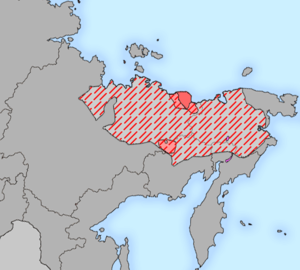

| Yukaghir | |
|---|---|
| Ethnicity | Yukaghirs, Chuvans, Anauls |
| Geographic distribution | Russian Far East |
| Linguistic classification | ?Uralic–Yukaghir; Otherwise one of the world's primary language families |
| Proto-language | Proto-Yukaghir |
| Subdivisions | |
| Glottolog | yuka1259 |
 Extent of Yukaghir languages in the 17th (hatched) and 20th (solid) centuries | |
The Yukaghir languages (/ˈjuːkəɡɪər/ YOO-kə-geeror/juːkəˈɡɪər/ yoo-kə-GEER; also Yukagir, Jukagir) are a small family of two closely related languages—Tundra and Kolyma Yukaghir—spoken by the Yukaghir in the Russian Far East living in the basin of the Kolyma River. At the 2002 Russian census, both Yukaghir languages taken together had 604 speakers.[1] More recent reports from the field reveal that this number is far too high: Southern Yukaghir had maximum 60 fluent speakers in 2009, while the Tundra Yukaghir language had around 60–70. The entire family is thus to be regarded as moribund.[2] The Yukaghir have experienced a politically imposed language shift in recent times, and a majority also speak Russian and Yakut.
In the Russian 2020-2021 census, 516 people reported speaking a Yukaghir language as their native language.[3]

The relationship of the Yukaghir languages with other language families is uncertain, though it has been suggested that they are distantly related to the Uralic languages, thus forming the putative Uralic–Yukaghir language family.[4]
Michael Fortescue argued that Yukaghir is related to the Eskimo-Aleut languages along with Uralic languages, forming the Uralo-Siberian language family.[5]
Tundra and Kolyma Yukaghir are the only two remnants of what used to be one of the dominant languages/language families of northeastern Siberia, spreading from the River Anadyr in the east to the River Lena in the west.[6] On the basis of the evidence of early sources, it can be assumed that there existed a Yukaghir dialect continuum, with what is today Tundra Yukaghir and Kolyma Yukaghir at the extremes.[7]
These two languages share only a relatively small part of the vocabulary and are not mutually intelligible. The basic grammatical structures, however, are very similar. Both languages have residual vowel harmony and a complex phonotactics of consonants. Both have rich agglutinative morphology and are strictly head-final. There is practically no finite subordination and very few coordinate structures. The most spectacular feature of TY and KY grammar is the split intransitive alignment system based on discourse-pragmatic features. In absence of narrow focus, the system is organised on the nominative–accusative basis; when focused, direct objects and subjects of intransitive verbs are co-aligned (special focus case, special focus agreement).
The two extant varieties of Yukaghir are:
Extinct varieties include Omok and Chuvan, which survived until perhaps the 18th century.
Some lexical differences between Kolyma Yukaghir and Tundra Yukaghir:[8]: 150
| gloss | Kolyma Yukaghir | Tundra Yukaghir |
|---|---|---|
| one | irkēj | mōrqōñ |
| two | ataqlōj | kijōñ |
| five | iñhañbōj | imd’ald’añ |
| many | niŋel | pojōl |
| all | t’umu | jawnə |
| day | pod’erqə | t’ajləŋ |
| sun | jelōd’ə | jerpəjəŋ |
| water | ōd’ī | lawjəŋ |
| fish | anil | al’həŋ |
| reindeer | at’ə | il’eŋ |
| dog | pubel | laməŋ |
| person | šoromə | ködeŋ |
| people | omnī | t’īŋ |
| eye | aŋd’ə | jȫd’īŋ |
| tooth | todī | sal’hərīŋ |
| night | emil | t’iŋit’əl |
| foot | nojl | t’ohul |
| name | ñū | kirijəŋ |
| to sit | modo- | sahañeto |
| kill | kuledə- | puñīto |
| die | amdə- | jabəto |
| know | leidī- | kurilīto |
| drink | ožə- | law- |
Article 1 of the Universal Declaration of Human Rights:
Көдэҥ тэн – ньидитэ бандьэ параwааньэрэҥ тудэ чуҥдэн ньилдьилэк эннулҥинь-мэдьуолнуни. Көдэҥ энмун чундэ мэ льэй, таатльэр лукундьии ньинэмдьийилпэ дитэ эннуйуол-мораwньэҥи.
Latin:
Ködeng ten – n'idite band'e parawaan'ereng tude chungden n'ild'ilek ennulngin'-med'uolnuni. Ködeng enmun chunde me l'ey, taatl'er lukund'ii n'inemd'iyilpe dite ennuyuol-morawn'engi.
English translation:
All human beings are born free and equal in dignity and rights. They are endowed with reason and conscience and should act towards one another in a spirit of brotherhood.
|
| ||||||
|---|---|---|---|---|---|---|
| Chukotko-Kamchatkan |
| |||||
| Yeniseian |
| |||||
| Yukaghir |
| |||||
| Nivkh |
| |||||
| Others |
| |||||
Italics indicate extinct languages | ||||||
|
| |
|---|---|
| Federal language |
|
| State languages of federal subjects |
|
| Languages with official status |
|
| Scripts |
|
1 In Russia, the Cyrillic alphabet is officially supported. 2 For other, non-Cyrillic alphabets, separate federal laws are required. | |
|
| |||||||
|---|---|---|---|---|---|---|---|
| Europe |
| ||||||
| West Asia |
| ||||||
| Caucasus |
| ||||||
| South Asia |
| ||||||
| East Asia |
| ||||||
| Indian Ocean rim |
| ||||||
| North Asia |
| ||||||
| Proposed groupings |
| ||||||
| Substrata |
| ||||||
| |||||||